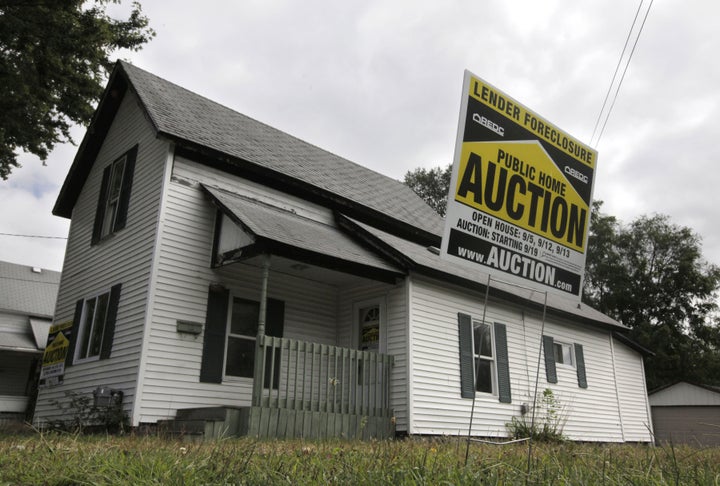
Only about a third of the homeowners who have successfully completed the trial period of the Obama administration's mortgage modification program have been offered permanent relief, according to new federal data obtained by the Huffington Post.
The conversion rate -- about 33 percent -- is woefully short of what the Treasury Department had forecast. Treasury thought the rate would be "ranging up to 75 percent," Herbert M. Allison Jr., assistant secretary for financial stability, told the Congressional Oversight Panel in October.
The other two-thirds of homeowners who have gone through the trial program and made the necessary payments remain in limbo. Some of those homeowners -- more than 350,000 of them -- will ultimately lose out on the kind of relief the administration has repeatedly promised: averting foreclosure through lower monthly payments.
"I remain very concerned about the relatively small number of conversions from trial to permanent modifications for homeowners," said Richard H. Neiman, New York's superintendent of banks and a member of the COP, in an email to HuffPost. "Hundreds of thousands of homeowners are left in limbo by [mortgage] servicers and [are] once again at risk of foreclosure."
Rep. Jim Jordan, an Ohio Republican on the House Oversight Committee who had a memorable exchange last month with one of Treasury's top housing officials, was more blunt: "It's not surprising these numbers are lower than expected," he said in an email. "This program has been a waste of taxpayer dollars and harmful to the very families it was supposed to help."
The Home Affordable Modification Program, a year-old initiative which promised to help up to four million homeowners avoid foreclosure through lower monthly payments, is the administration's signature effort to help struggling borrowers stay in their homes. Part of Obama's $75 billion Making Home Affordable program, HAMP is designed to help homeowners by paying everyone in the mortgage chain, from the borrower to the mortgage bond investor.
But this incentive-based program, criticized by many consumer advocates and Wall Street housing analysts as inadequate and ineffective, has had a rocky time delivering on its promise.
The new data was contained in a series of answers by Treasury Secretary Timothy Geithner to questions posed by Neiman and his colleagues on COP, including Harvard Law professor and bailout watchdog Elizabeth Warren.
"As of the end of January there were over 116,000 permanent modifications and over 67,000 permanent modifications pending final approval," Geithner wrote in his letter, which the panel received last week. "This group of approximately 180,000 permanent and pending permanent modifications represents about a third of the population of total modifications who have completed the trial modification and are at a point in the process where they are able to convert to permanent."
Geithner added that he recognizes that "there is much additional work to be done in converting borrowers to permanent modifications."
Rep. Dennis Kucinich, chairman of House Oversight's Domestic Policy subcommittee, said in an interview that Treasury isn't devoting as much attention to homeowners as it does to Wall Street.
"Treasury has been very slow to use the authority provided by Congress... to help keep homeowners in their homes," the Ohio Democrat told HuffPost. "And this contrasts with the emergency with which both [the Bush and Obama] administrations have worked to bail out the large financial institutions."
Kucinich said there's only one solution left.
"I've come to the reluctant conclusion that the only way to accelerate the program and also provide adequate incentives for homeowners who sacrifice to stay in their own homes is through permanent, locally-tailored, unconditional reductions in mortgage principal," he said.
Federal Deposit Insurance Corp. Chairman Sheila Bair advocates principal write-downs to help distressed borrowers, particularly for "underwater" homeowners -- those who owe more on their mortgage than the underlying home is worth. More than 11 million homeowners, comprising about a quarter of all homeowners with a mortgage, are underwater, according to real estate research firm First American CoreLogic.
A senior Treasury official told HuffPost on Monday that the department was heading towards more writing down of principal as part of its mortgage modification efforts, and that an announcement was to be expected in the next few weeks. But a Treasury spokesman e-mailed to say that Treasury was "NOT poised to roll out a major principal write-down program."
Treasury has steadfastly refused to make principal write-downs a significant part of its foreclosure-prevention efforts. Officials have repeatedly used the phrase "moral hazard" -- a theory that posits that when people enjoy the fruits of their actions without having to suffer any of the consequences they do it more -- to explain why they don't want to write down mortgage principal for homeowners.
Kucinich was pessimistic about the ability of any program that doesn't involve principal reductions to help floundering homeowners. "Instead, we're going to stay on this slow path to default, foreclosure and personal bankruptcy," Kucinich said. "And our economy is going to continue to suffer."
He added: "It's funny that moral hazard is a concept when it comes to Main Street but not to Wall Street," a reference to the massive bank bailouts.
More than 2.8 million homes were lost to foreclosure last year, according to data provider RealtyTrac. The firm expects a record three million foreclosures this year.
READ Geithner's responses below:
